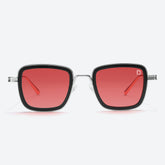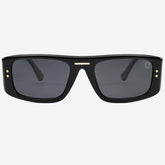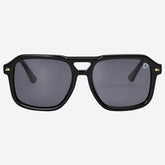When Were Sunglasses Invented: The History Of Sunglasses?
We’ve all come to know and love our sunglasses. They’re the ultimate fashion accessory, able to make you look instantly cool if you sport one that matches your face shape and style. But, have you ever asked, when were sunglasses invented? Do you know that as far back as two thousand years ago, people have been using some primitive form of sunglasses? Well, in this article, we’ll look into the history of sunglasses and how this essential fashion accessory came to become a staple for all fashion lovers. We’ll also look at its journey of evolution over the centuries.
When Were Sunglasses Invented?
No one knows the specific era when sunglasses were invented. However, research has shown that Nero’s hand-held gems and the Arctic goggles of the Inuit—two of the oldest known precursors to modern-day sunglasses, occurred around the same period, roughly 2,000 years ago.
Who Invented Sunglasses?

Just like no one can answer the question, “When were sunglasses invented?” no one really knows definitively who invented the first pair of sunglasses. However, some people believe the Venetian gondoliers of the 18th century to be the first people to wear sunglasses because the tinted glasses they wore then most resemble those we use now. Before then, people at different periods in history have used different objects to protect their eyes from the sun. One such person is Emperor Nero of the Roman Empire, who was known to protect his eyes from the sun using gems.
Where Were Sunglasses Invented?
We can’t pinpoint a specific place in history where sunglasses were first invented, as people most likely simultaneously invented different ways to protect their eyes from the sun in different parts of the world. We already discussed how Emperor Nero used his gems. Meanwhile, those living in the Arctic region protected their eyes by cutting slits into hard materials like bones and wearing them over their eyes. Each civilization found a way to protect its eyes using the natural resources available to them at the time.
The Evolution of Sunglasses
While there’s no accurate historical timeline of how sunglasses came to become a part of our culture, we can view certain developments as noteworthy milestones during this process. These milestones are the best answer we can get to the question, “When were sunglasses invented?” We look at these milestones below.
Arctic Snow Goggles: Inuit Sunglasses

As we mentioned earlier in this article, the Inuit tribe created a form of snow goggles about two thousand years ago. They protected their eyes from the intense rays of the sun with these goggles. However, these goggles don’t look like the sunglasses we use now. To make the goggles, the Inuit made slits in wood, bones, or other hard materials and wore them over their eyes.
The narrow slits gave the wearer clearer vision by narrowing their field of vision and giving a more focused view. The narrow slit also lessened the amount of light entering their eyes, both from the sun and those reflecting off the snow. This was really important because reflections from the snow can be really bright and can lead to photokeratitis, which is a kind of sunburn that affects the eyes instead of the skin.
The Emperor’s Emeralds

As we also noted earlier, Emperor Nero of the ancient Roman Empire is believed to have used emerald gems to protect his eyes whenever he watched the gladiator matches held outdoors. Historians believed the gems filtered out the glare of the sun. The emeralds were probably not just for protecting his eyes from the sunlight, though. They probably also helped him see more clearly, especially with distance objects. The emeralds also attested to his royalty.
Chinese Smoky Quartz Glasses

The next noteworthy milestone was in the 12th century when ancient Chinese began to wear see-through goggles made of smoky quartz to protect their eyes from the sun. Historians believe these sunglasses were almost as expensive as horses at that time, meaning their wearers were probably wealthy.
The wealthy weren’t the only ones to wear smoky quartz goggles at the time, though. Chinese judges also wore them, especially while adjudicating a case. The reason for wearing the goggles was to ensure their facial expressions remained hidden during trials. Asides from this, the smoky quartz goggles were also used for ceremonial or therapeutic purposes.
Ayscough’s 18th-Century Sunglasses

The 18th century was when we began to witness sunglasses that truly bear some resemblance to what we have in the modern day. It started with James Ayscough, an English optician, inventing special tinted glasses in 1752. This pair of eyeglasses also had side pieces that were tinted. Many view these eyeglasses as the first predecessor of modern sunglasses.
Ayscough’s eyeglasses weren’t really created to be sunglasses, though. They were used in England mostly by people who were extremely sensitive to light as a form of therapy. They were mostly green or blue tint because these colors were believed to relieve eye discomfort.
Goldoni Glasses for Gondoliers

Still in the 18th century, but much later in the century, gondoliers in the town of Venice in Italy began to wear tinted eyeglasses to shield their eyes from harsh sunlight. Some believe these to be the actual predecessor of modern sunglasses because, unlike Ayscough’s eyeglasses, these glasses were specifically created to protect the eyes from the sun. A famous playwright in that era, Carlo Goldoni made these sunglasses popular and wore them several times. They came to be known as Goldoni glasses.
Mass-Produced Sunglasses
1929 was a year that saw a major milestone in the evolution of sunglasses. Savvy American entrepreneur Sam Foster—who founded the Foster Grant Company—found a way to mass-produce sunglasses. His sunglasses were inexpensive, made with celluloid using injection moulding. He started selling them on the boardwalk in Atlantic City, New Jersey. As the products were cheap and stylish, the demand skyrocketed, and their popularity grew.
Aviator Sunglasses Take Flight
The next milestone in the evolution of sunglasses, as we answer the question, “When were sunglasses invented?” is the creation of aviator sunglasses. With man having conquered the skies in the early 20th century, and aircraft becoming an effective and devastating option in warfare, there was a need to help pilots protect their eyes from the glare of the sun while in the air. The U.S. Army Air Corps commissioned aviator sunglasses for their pilots in 1930, and it proved to be a successful innovation. The original sunglasses had dark green tinted lenses. However, research has shown that rose-tinted sunglasses are better at protecting the pilots’ eyes.
A Polarizing Technology

Polarized sunglasses share a common historical fact with many inventions (and rock bands); it was developed in a garage. Edwin H. Land developed polarized lenses, which essentially have special filters that block out harsh rays of light from the sun or those reflected from surfaces like snow. His invention in 1936 increased visibility greatly and made outdoor activities much safer. Land went on to start a company named the Polaroid Corporation.
Soon after, Land’s polarized lenses inspired the now-popular eyeglasses brand Ray Ban to create aviator sunglasses that had polarized lenses. Ray Ban is a brand owned by Bausch and Lomb, an American eye health company. American Air Force pilots extensively used Their polarized sunglasses during World War II. In 1937, polarized sunglasses became available to the public in different frame shapes and lens colors.
Types Of Sunglasses By Frame Styles
Aviators

Aviators have teardrop-shaped lenses and a double bridge that creates a classic, sophisticated look. Often made with metal frames, aviators are perfect for both casual and formal wear. Their timeless design suits various face shapes and styles, from retro to modern. They add a touch of elegance and refinement to any outfit. Shop from our list of aviator sunglasses here.
Wayfarers

Wayfarers have a timeless design featuring a distinctive shape and plastic frame. Wayfarers are versatile and suit various face shapes and styles. They are also perfect for both men and women, and their classic design makes them suitable for both casual and formal wear. Wayfarers are a popular choice for their comfort, durability, and stylish appeal.
Rectangles
Rectangular frames are simple, sleek, and minimalist. They are ideal for those seeking a clean, modern look. Suitable for both men and women, they complement most face shapes and styles. Rectangular frames are perfect for those who prefer a subtle, understated look that still makes a fashion statement.
Rounds
Circular lenses and frames evoke a vintage, retro feel, perfect for adding a touch of nostalgia to your style. Round frames suit most face shapes and are ideal for those seeking a unique, fashion-forward look. They add a playful, quirky touch to any outfit and are perfect for making a statement.
Oversized
Large lenses and frames make a bold fashion statement, ideal for those seeking a trendy, glamorous look. Oversized frames are perfect for making a statement and drawing attention to your face. They suit most face shapes and are ideal for those who want to add a touch of drama to their style.
Cat-Eyes
Curved frames resembling a cat's eye add a touch of femininity and elegance. They are suitable for women seeking a stylish, sophisticated look, cat-eye frames complement most face shapes and styles. They add a playful, flirtatious touch to any outfit and are perfect for making a fashion statement.
Geometric
Unconventional shapes like hexagons or triangles create a bold, fashion-forward statement. They’re ideal for those seeking a unique, edgy look, and geometric frames are perfect for making a statement. They suit most face shapes and styles, adding a touch of modernity and sophistication to any outfit.
Conclusion
Sunglasses have come a long way from the primitive gems of Emperor Nero and the bone slits of the Inuits about two thousand years ago. Modern sunglasses offer more than their predecessors, both in terms of style and protection from the sun's harmful UV radiation. Each day we see new stylish creations that offer new perspectives on how sunglasses look with different frame styles and lens colors. While we may not know so much about the history of sunglasses, we certainly know its future is bright.





